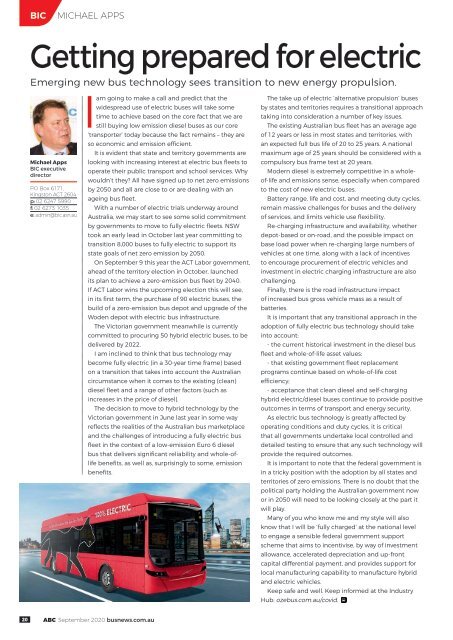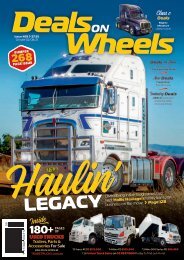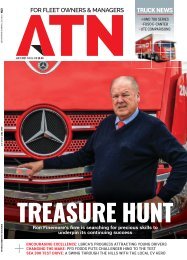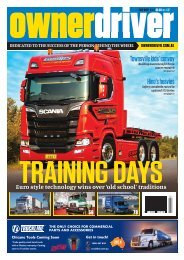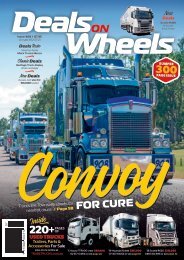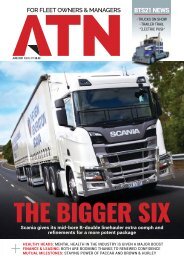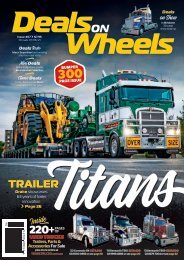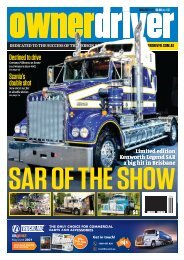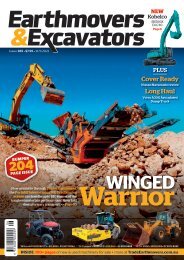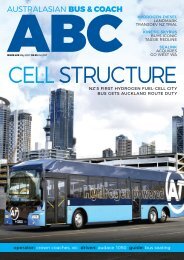ABC #397
You also want an ePaper? Increase the reach of your titles
YUMPU automatically turns print PDFs into web optimized ePapers that Google loves.
BIC<br />
MICHAEL APPS<br />
Getting prepared for electric<br />
Emerging new bus technology sees transition to new energy propulsion.<br />
Michael Apps<br />
BIC executive<br />
director<br />
PO Box 6171,<br />
Kingston ACT 2604<br />
p: 02 6247 5990<br />
f: 02 6273 1035<br />
e: admin@bic.asn.au<br />
I<br />
am going to make a call and predict that the<br />
widespread use of electric buses will take some<br />
time to achieve based on the core fact that we are<br />
still buying low emission diesel buses as our core<br />
‘transporter’ today because the fact remains – they are<br />
so economic and emission efficient.<br />
It is evident that state and territory governments are<br />
looking with increasing interest at electric bus fleets to<br />
operate their public transport and school services. Why<br />
wouldn’t they? All have signed up to net zero emissions<br />
by 2050 and all are close to or are dealing with an<br />
ageing bus fleet.<br />
With a number of electric trials underway around<br />
Australia, we may start to see some solid commitment<br />
by governments to move to fully electric fleets. NSW<br />
took an early lead in October last year committing to<br />
transition 8,000 buses to fully electric to support its<br />
state goals of net zero emission by 2050.<br />
On September 9 this year the ACT Labor government,<br />
ahead of the territory election in October, launched<br />
its plan to achieve a zero-emission bus fleet by 2040.<br />
If ACT Labor wins the upcoming election this will see,<br />
in its first term, the purchase of 90 electric buses, the<br />
build of a zero-emission bus depot and upgrade of the<br />
Woden depot with electric bus infrastructure.<br />
The Victorian government meanwhile is currently<br />
committed to procuring 50 hybrid electric buses, to be<br />
delivered by 2022.<br />
I am inclined to think that bus technology may<br />
become fully electric (in a 30-year time frame) based<br />
on a transition that takes into account the Australian<br />
circumstance when it comes to the existing (clean)<br />
diesel fleet and a range of other factors (such as<br />
increases in the price of diesel).<br />
The decision to move to hybrid technology by the<br />
Victorian government in June last year in some way<br />
reflects the realities of the Australian bus marketplace<br />
and the challenges of introducing a fully electric bus<br />
fleet in the context of a low-emission Euro 6 diesel<br />
bus that delivers significant reliability and whole-oflife<br />
benefits, as well as, surprisingly to some, emission<br />
benefits.<br />
The take up of electric ‘alternative propulsion’ buses<br />
by states and territories requires a transitional approach<br />
taking into consideration a number of key issues.<br />
The existing Australian bus fleet has an average age<br />
of 12 years or less in most states and territories, with<br />
an expected full bus life of 20 to 25 years. A national<br />
maximum age of 25 years should be considered with a<br />
compulsory bus frame test at 20 years.<br />
Modern diesel is extremely competitive in a wholeof-life<br />
and emissions sense, especially when compared<br />
to the cost of new electric buses.<br />
Battery range, life and cost, and meeting duty cycles,<br />
remain massive challenges for buses and the delivery<br />
of services, and limits vehicle use flexibility.<br />
Re-charging infrastructure and availability, whether<br />
depot-based or on-road, and the possible impact on<br />
base load power when re-charging large numbers of<br />
vehicles at one time, along with a lack of incentives<br />
to encourage procurement of electric vehicles and<br />
investment in electric charging infrastructure are also<br />
challenging.<br />
Finally, there is the road infrastructure impact<br />
of increased bus gross vehicle mass as a result of<br />
batteries.<br />
It is important that any transitional approach in the<br />
adoption of fully electric bus technology should take<br />
into account:<br />
- the current historical investment in the diesel bus<br />
fleet and whole-of-life asset values;<br />
- that existing government fleet replacement<br />
programs continue based on whole-of-life cost<br />
efficiency;<br />
- acceptance that clean diesel and self-charging<br />
hybrid electric/diesel buses continue to provide positive<br />
outcomes in terms of transport and energy security.<br />
As electric bus technology is greatly affected by<br />
operating conditions and duty cycles, it is critical<br />
that all governments undertake local controlled and<br />
detailed testing to ensure that any such technology will<br />
provide the required outcomes.<br />
It is important to note that the federal government is<br />
in a tricky position with the adoption by all states and<br />
territories of zero emissions. There is no doubt that the<br />
political party holding the Australian government now<br />
or in 2050 will need to be looking closely at the part it<br />
will play.<br />
Many of you who know me and my style will also<br />
know that I will be ‘fully charged’ at the national level<br />
to engage a sensible federal government support<br />
scheme that aims to incentivise, by way of investment<br />
allowance, accelerated depreciation and up-front<br />
capital differential payment, and provides support for<br />
local manufacturing capability to manufacture hybrid<br />
and electric vehicles.<br />
Keep safe and well. Keep informed at the Industry<br />
Hub: ozebus.com.au/covid.<br />
20<br />
<strong>ABC</strong> September 2020 busnews.com.au


